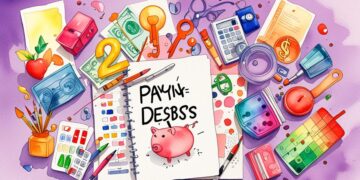How to Pay Off Credit Card Debt Faster with the Snowball Method

Understanding the Snowball Method
Managing credit card debt can feel overwhelming, but there is a method that can help you tackle it effectively: the Snowball Method. This strategy focuses on paying off your debts in a way that builds momentum and motivation. By targeting your smallest debts first, you can achieve quick wins that encourage you to keep going. This technique is not just about financial management; it nurtures a positive mindset that can lead to long-term financial health.
How the Snowball Method Works
To apply the Snowball Method, start by taking a structured approach:
- List your debts: Begin by organizing all of your debts from the smallest balance to the largest balance. For example, if you have debts of $200, $1,000, and $3,500, your list should start with the $200 debt. This is crucial because it sets the foundation for your repayment strategy.
- Make minimum payments: It’s important to keep making the minimum payments on all your debts every month. This ensures you avoid any late fees and prevents your credit score from suffering.
- Attack the smallest debt: Focus on any extra money you can allocate towards your smallest debt. For instance, if you typically spend $50 a month on dining out, consider redirecting that money to pay off the $200 debt. Paying off this debt quickly not only eliminates it but also gives you a sense of accomplishment.
- Move to the next one: Once your smallest debt is paid off, take the total amount you were paying on that debt and apply it to the next smallest debt. Continuing the previous example, if your next debt is $1,000, instead of making only the minimum payment, add the $50 from the now-closed $200 debt. This creates a larger payment, which can hasten your repayment process.
This method not only simplifies debt management but also provides a psychological boost. With each debt you eliminate, you gain confidence and motivation to tackle the next one. It’s akin to a snowball gathering size and speed as it rolls downhill—what starts small quickly becomes much larger and more powerful.
The Benefits of the Snowball Method
Beyond merely paying off debt, the Snowball Method builds positive habits. It reinforces the notion that progress is possible, which can inspire you to make further changes in your financial behavior. The sense of achievement you experience when paying off each debt can lead to better budgeting, reduced spending, and ultimately, increased savings. Utilizing this strategy can transform your approach to money management, shifting your perspective from one of anxiety to one of empowerment.
To visualize your path to becoming debt-free, consider a real-life scenario. Imagine you have three debts: a credit card debt of $300, a personal loan of $1,200, and a car loan of $5,000. By paying off the $300 credit card debt first, you can revel in that success, motivating you to focus on the $1,200 personal loan next, and then, finally, the larger car loan. By progressively knocking off these debts, you create a powerful cycle of victory that will propel you forward in your journey towards financial freedom.
In conclusion, by understanding and applying the Snowball Method, you can turn your financial situation around and gain control of your spending habits. It provides a clear roadmap for tackling debt while simultaneously reinforcing a mindset geared towards success.
CHECK OUT: Click here to explore more
Getting Started with the Snowball Method
Embarking on the journey to pay off credit card debt using the Snowball Method starts with a solid plan. By organizing your debts and committing to a repayment strategy, you can overcome financial obstacles and build a brighter financial future. Here’s how you can get started:
Gather Your Financial Information
The first step is to collect all the relevant information about your debts. You should know how much you owe, what the interest rates are, and the minimum payments required for each account. This will help you identify which debts to tackle first. Here’s a simple process to follow:
- Make a list: Write down all your debts, including credit card balances, personal loans, and other types of outstanding debts.
- Note amounts and interest rates: For each debt, include the remaining balance and the interest rate. This will give you insight into priority debts, but remember, with the Snowball Method, the focus is primarily on the balance.
- Identify minimum payments: Record the minimum payment required for each debt to ensure you maintain good standing while focusing on your smallest debt.
Create a Budget
Next, it’s crucial to create a budget that allows you to allocate extra funds towards your smallest debt. Review your monthly income and expenses to identify areas where you can cut back. It may involve making some sacrifices, but every dollar counts. Consider these tips:
- Track your spending: Use budgeting apps or a simple spreadsheet to see where your money goes every month. Identify non-essential expenses that can be trimmed.
- Redirect funds: If you uncover any areas where you consistently overspend, such as dining out or subscriptions, aim to redirect that money toward your smallest debt.
- Create a debt repayment goal: Set a realistic time frame for paying off your smallest debt. For instance, if you want to pay off a $200 credit card debt in two months, you would need to allocate $100 additional each month.
Stay Committed and Motivated
As you begin to implement the Snowball Method, your mindset is vital for long-term success. Maintaining motivation is essential, especially when the debts are numerous or the amounts large. Here are some strategies to keep you engaged:
- Celebrate small wins: Each time you pay off a debt, take a moment to celebrate your achievement, no matter how minor it may seem. This positivity reinforces your commitment.
- Visualize your progress: Consider keeping a visual representation of your debts, such as a chart or a graph. Watching your debts decrease can provide motivation to stick with your plan.
- Seek encouragement: Share your goals with supportive friends or family members. They can provide encouragement and help keep you accountable throughout your journey.
By getting started with these foundational steps and remaining focused on your goal, you can gradually overcome your credit card debt. The Snowball Method not only simplifies your strategy but also creates a positive feedback loop that can ultimately lead to financial independence.
SEE ALSO: Click here to read another article
Implementing the Snowball Method
Once you have gathered your financial information and created a budget, it’s time to put the Snowball Method into practice. This strategy involves focusing your efforts on your smallest debt first, while making minimum payments on your other debts. The essence of this method lies in the psychological boost you gain from paying off debts quickly. Here’s how to implement it effectively:
Identify Your Smallest Debt
Now that you have your list of debts, find the one with the smallest balance, regardless of the interest rate. For example, if you have three credit cards with balances of $200, $500, and $1,000, your smallest debt is the one with a $200 balance. This smaller amount allows you to see tangible results faster, which can be incredibly motivating.
Focus Payments on the Smallest Debt
With your budget established, direct any extra funds toward the payment of your smallest debt. Continue making the minimum payments on your other debts. For illustration, let’s say you have a minimum payment of $25 for your smallest debt. You’re also able to allocate an additional $75 from your budget. This means you can pay $100 towards that debt each month.
By following this plan, you’ll pay off the less daunting $200 debt in just two months. Once eliminated, you can shift your focus to the next smallest debt on your list, which would likely feel much more manageable with the momentum you’ve built.
Utilizing Extra Funds Wisely
To accelerate your debt repayment even further, consider utilizing any extra funds you might receive. This could be a tax refund, a bonus from work, or even side gig earnings. Allocate this additional income directly toward your smallest debt. For example, if you receive a $500 bonus, put that entire amount towards your smallest debt, which significantly shortens the time it takes to pay it off.
Continuously Reevaluate Your Progress
As you pay off debts, it’s important to reassess your financial situation regularly. After you successfully eliminate your smallest debt, take a moment to review your updated list and budget. The snowball effect now begins to take shape: all the money you were previously using to pay off your smallest debt can now be redirected to your next smallest debt. For instance:
- If you were paying $100 towards your smallest debt and the next smallest debt has a minimum payment of $30, you can now put a total of $130 every month toward that second debt.
- This increased payment accelerates the process of paying it off, allowing you to maintain the momentum of your progress.
Staying on Track and Adjusting as Needed
Maintaining focus can be challenging, but consistency is key. Life can bring unexpected expenses, so be prepared to adjust your budget and spending as necessary. If you encounter difficulties, take a step back and reassess your budget. Perhaps you can find new ways to save money or increase your income slightly to keep your repayment journey on course.
Engaging with personal finance communities online, such as forums or social media groups dedicated to debt repayment, can also be helpful. Sharing your successes and challenges can provide additional motivation and access to new strategies for keeping you accountable.
Implementing the Snowball Method effectively requires commitment, flexibility, and focus, but by following these practical steps, you can significantly speed up your journey to becoming debt-free. The satisfaction of wiping out one debt after another will fuel your drive toward financial freedom.
CHECK OUT: Click here to explore more
Conclusion
In conclusion, the Snowball Method presents a practical and psychologically effective approach to eliminating credit card debt. By focusing on your smallest debts first and gradually building momentum, you can achieve a sense of accomplishment that reinforces your commitment to becoming debt-free. It’s important to remember that this process is more than just numbers; it’s about fostering a positive mindset that encourages financial stability.
Starting with manageable payments allows you to see quick results, motivating you to continue tackling larger debts as you progress. Utilizing extra funds wisely, such as bonuses or tax refunds, accelerates your journey and amplifies the snowball effect. Regularly reassessing your budget and adapting as necessary ensures that you stay on track, even when faced with unexpected expenses.
Ultimately, while the Snowball Method requires dedication and consistency, the benefits of mastering your credit card debt are invaluable. With each debt you eliminate, you pave the way towards greater financial freedom and less stress in your life. Embrace this method not only as a debt repayment strategy but as a pathway to building better financial habits that will serve you well in the long run.
Empower yourself with the knowledge that you have the tools to regain control over your finances. Start small, stay committed, and watch as you progress towards a debt-free lifestyle.

Linda Carter is a writer and financial consultant specializing in personal finance and money management. With years of experience helping individuals and families achieve financial stability and make informed decisions, Linda shares her expertise on the True Metronome platform. Her goal is to empower readers with practical advice and strategies to take control of their finances and build a secure future.





